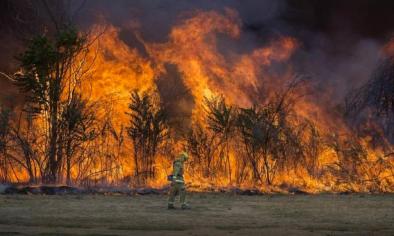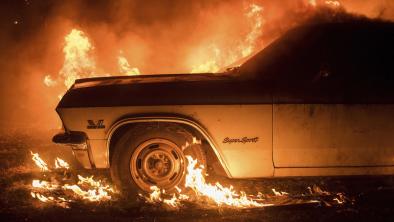Science Source
Direct and indirect climate controls predict heterogeneous early-mid 21st century wildfire burned area across western and boreal North America
- States that as climate warms, seasonal climate and snowpack co-vary in intricate ways, influencing fire at continental and sub-continental scales
- Uses independent records of seasonal climate and snow cover duration (last date of permanent snowpack, LDPS) and cell-based Structural Equation Models (SEM) to separate direct (climatic) and indirect (snow cover) effects on relative changes in annual area burned (AAB) under future climatic scenarios across western and boreal North America
- Runs multiple regression models of log-transformed AAB on seasonal climate variables and LDPS to isolate seasonal climate variables with the greatest effect on AAB
- Uses the results of multiple regressions to project future AAB using GCM ensemble climate variables and LDPS, and validated model predictions with recent AAB trends
- Finds that direct influences of spring and winter temperatures on AAB are larger and more widespread than the indirect effect mediated by changes in LDPS in most areas
- Finds that despite significant warming trends and reductions in snow cover duration, projected responses of AAB to early-mid 21st century are heterogeneous across the continent
- Finds that changes in AAB range from strongly increasing (one order of magnitude increases in AAB) to moderately decreasing (more than halving of baseline AAB)
- Concludes that annual wildfire area burned in coming decades is likely to be highly geographically heterogeneous, reflecting interacting regional and seasonal climate drivers of fire occurrence and spread
Related Content
Science Source
| Environmental Research Letters
Identification of two distinct fire regimes in Southern California: implications for economic impact and future change
Yufang Jin, Michael L Goulden, Nicolas Faivre et al
Science Source
| Journal of Arid Environments
Trends and drivers of fire activity vary across California aridland ecosystems
Alexandra D.Syphard, Jon E.Keeley, John T.Abatzoglou
Headline

Jul 17, 2017 | McClatchy DC
Climate change could burn a hole in the Forest Service’s budget
Headline

Jul 13, 2017 | NBC Southern California
California Wildfires Feed on Grass Brought on by Winter Rain


